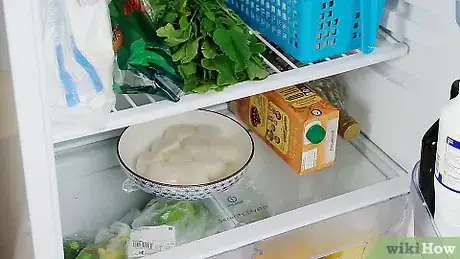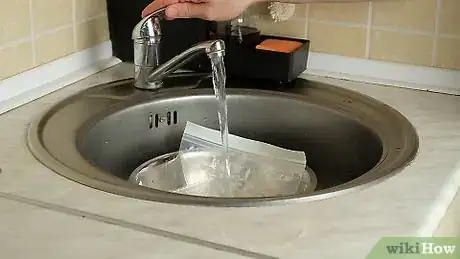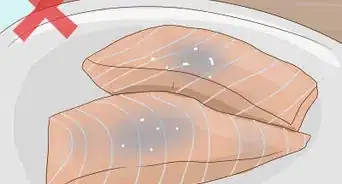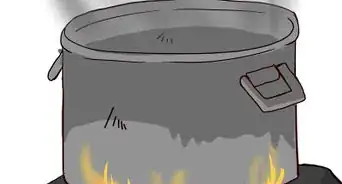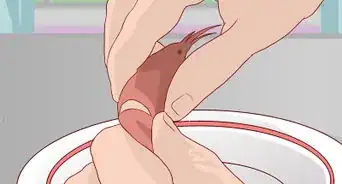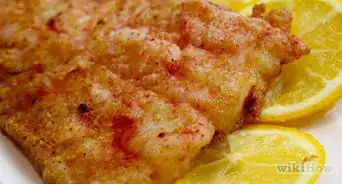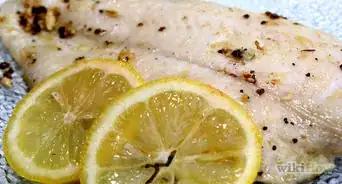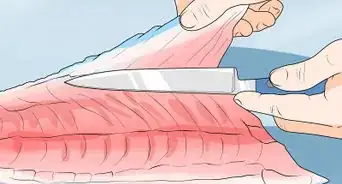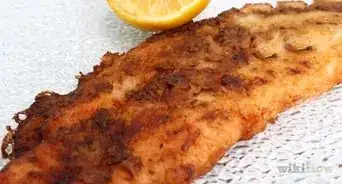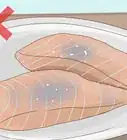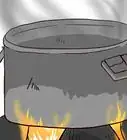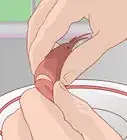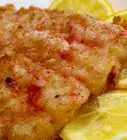This article was co-authored by wikiHow Staff. Our trained team of editors and researchers validate articles for accuracy and comprehensiveness. wikiHow's Content Management Team carefully monitors the work from our editorial staff to ensure that each article is backed by trusted research and meets our high quality standards.
The wikiHow Video Team also followed the article's instructions and verified that they work.
This article has been viewed 157,689 times.
Learn more...
Frozen scallops need to be thawed properly to avoid changing the scallop from its natural delicate texture to a tough and chewy consistency. The best method of defrosting is to allow the frozen scallops to thaw on their own in your refrigerator. But if you’re pressed for time, you can run them under cool water or even microwave them to speed up the defrosting process.
Steps
Thawing in the Refrigerator
-
1Defrost your scallops in the refrigerator for the best results. Although it takes much more time to allow your frozen scallops to fully thaw in the refrigerator, it will produce the best-tasting scallops. And because the frozen scallops will defrost gradually, there’s almost no chance of damaging or contaminating the scallops during the thawing process.[1]
- Because thawing your scallops in the refrigerator takes a full day, make sure you plan ahead and give yourself enough time to allow them to fully defrost before you use them!
-
2Set your refrigerator’s temperature to 37 °F (3 °C). The temperature of your refrigerator is the most important part of allowing your scallops to defrost properly. The best temperature for your frozen scallops is right at 37 °F (3 °C), so adjust your refrigerator’s temperature accordingly.[2]
Tip: Most standard refrigerators are set at 35 °F (2 °C). Make sure you don’t have any other foods in your fridge that could spoil at 37 °F (3 °C). If so, consider finding another suitable storage space while your scallops defrost.
Advertisement -
3Remove the scallops from their packaging and place them in a large bowl. The bowl needs to be large enough to fit all of the scallops. It also needs to have enough extra room for any water that forms from the melting ice around the scallops. Take the scallops out of their packages and arrange them so that the bowl is about ¾ of the way full.[3]
- Use another bowl if you have too many scallops to fit in one bowl.
-
4Cover the bowl with plastic wrap. Because the scallops are slowly thawing, they are at risk of becoming contaminated and spoiling. Wrap the bowl securely with plastic wrap to keep the scallops from coming into contact with any other food particles in your refrigerator.[4]
- If your bowl has a lid, you can use that to cover the scallops.
-
5Place the bowl of scallops on a low shelf in your refrigerator. Once you’ve covered the bowl with plastic wrap, clear some space in your refrigerator and place the bowl of scallops on a low shelf to keep them from coming into contact with any other food.
- Don’t put the bowl in a temperature controlled drawer unless the temperature is set to 37 °F (3 °C).
-
6Allow the scallops to defrost for 24 hours in your refrigerator. Let the bowl of scallops sit in your refrigerator for a full day undisturbed before you check them. Take the bowl out after 24 hours and check to see if the scallops have defrosted by touching the center of them with your finger. They should be cool but not frozen at all.[5]
- Frozen scallops can take on a rubbery, chewy texture if they’re cooked before they have fully defrosted.
- If your scallops haven’t fully defrosted after 24 hours, cover them again with plastic wrap and put them back into the refrigerator for another 6 hours.
Using Cool Water to Defrost
-
1Use cool water to defrost your frozen scallops more quickly. You can speed up the thawing process of your frozen scallops by using cool water if you don’t have the time to let them defrost on their own in your refrigerator. There also isn’t a risk of cooking the scallops using cool water.[6]
- The frozen scallops will defrost more quickly, but they may be a little tougher when they’re cooked.
-
2Put the frozen scallops into a resealable plastic bag. It’s important that the scallops do not come into direct contact with the water to avoid any potential contamination. Remove the scallops from their packaging and place them into a plastic bag and seal it.[7]
- Make sure the bag is sealed properly to prevent your scallops from getting waterlogged.
Tip: Try to remove as much air from the plastic bag as possible to keep it from floating on the water.
-
3Place the bag of frozen scallops into a large bowl. The bowl needs to be large enough to contain the bag of scallops and enough water to completely surround the bag. Make sure the bowl is clean before you put your shellfish into it to be sure there isn’t any risk of contamination.[8]
-
4Set the bowl in the sink and fill it with cold tap water. Move the bag of frozen scallops around a little while the bowl is filling up with water to make sure it doesn’t stick to the side. The water needs to be about 50 °F (10 °C) in order to thaw the frozen scallops without cooking them and changing their texture. Fill the bowl with enough water to cover the bag.[9]
- Keep the bowl in the sink in case you overfill it.
-
5Replace the water every 10 minutes for 30 minutes. Turn off the tap once the bowl is full and let the bag sit undisturbed. After 10 minutes, empty the water from the bowl and fill the bowl back up with cool water. After another 10 minutes, empty the water and check to see if the scallops have defrosted by touching them with your finger. They should be cool but soft with no frozen parts.
- It takes about 30 minutes total to defrost the scallops but larger frozen scallops can take longer.
- Make sure the bag is resealed after you check to see if the frozen scallops have defrosted.
- Do not refreeze the scallops after they’ve been defrosted.
Microwaving Scallops
-
1Use a microwave to defrost scallops if you are in a hurry. You need to use a microwave that has a defrost setting because scallops are very fragile and will start to cook if you use a standard setting to defrost them in a microwave. Check your microwave to see if it has a defrost setting.
- Scallops that have been defrosted in a microwave can be tougher and more chewy when they’re cooked.
-
2Put the frozen scallops in a microwave-safe bowl. Porcelain or glass containers with high sides are good to use to contain the water that will form from the melting ice around the frozen scallops. Remove the scallops from their packaging and place them into the bowl.[10]
- Use a bowl that is large enough to hold all of your scallops.
-
3Cover the bowl with a paper towel. Use a thick paper towel to cover the top of your bowl of scallops to reduce the risk of cooking the scallops when you defrost them in the microwave. The paper towel helps to absorb any steam or moisture that could change the texture of the scallops.[11]
- Thin paper towels can get soaked and may dissolve when they come into contact with the scallops as they defrost. Use a thick, three-ply paper towel.
-
4Microwave the scallops for 2 30-second segments on the defrost setting. You can’t undo it if you cook the scallops, so use short, 30 second increments to microwave-defrost your scallops. After 30 seconds is up, pull out the bowl and check to see if the scallops have fully defrosted by touching them with your finger. There shouldn’t be any remaining frozen parts.[12]
- If your scallops aren’t defrosted after 30 seconds, repeat the process until they are completely defrosted.
- Do not microwave defrost the scallops for more than four 30-second segments or the meat will start to cook and change texture.
Tip: Touch the center of the thickest scallop with your finger to confirm that all of the scallops are defrosted.
Warnings
- Do not refreeze frozen shellfish that have been thawed or they can spoil.⧼thumbs_response⧽
References
- ↑ https://www.fda.gov/food/buy-store-serve-safe-food/selecting-and-serving-fresh-and-frozen-seafood-safely
- ↑ https://www.fsis.usda.gov/wps/portal/fsis/topics/food-safety-education/get-answers/food-safety-fact-sheets/safe-food-handling/the-big-thaw-safe-defrosting-methods-for-consumers/
- ↑ https://www.aboutseafood.com/resource/thawing/
- ↑ https://www.aboutseafood.com/resource/thawing/
- ↑ https://www.bhg.com/recipes/how-to/cooking-basics/how-to-cook-scallops/
- ↑ https://www.aboutseafood.com/resource/thawing/
- ↑ https://www.aboutseafood.com/resource/thawing/
- ↑ https://thepioneerwoman.com/food-and-friends/how-to-cook-scallops/
- ↑ https://www.fsis.usda.gov/wps/portal/fsis/topics/food-safety-education/get-answers/food-safety-fact-sheets/safe-food-handling/the-big-thaw-safe-defrosting-methods-for-consumers/
